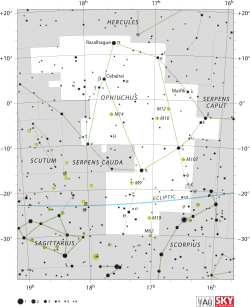 | |
| Observation data Epoch J2000.0 Equinox J2000.0 | |
|---|---|
| Constellation | Ophiuchus |
| Right ascension | 17h 47m 53.55973s[1] |
| Declination | +02° 42′ 26.2000″[1] |
| Apparent magnitude (V) | +3.753[2] |
| Characteristics | |
| Spectral type | A0 V[3] or A1VnkA0mA0[4] |
| U−B color index | +0.040[2] |
| B−V color index | +0.033[2] |
| Astrometry | |
| Radial velocity (Rv) | −7.6±0.3[5] km/s |
| Proper motion (μ) | RA: −24.64[1] mas/yr Dec.: −74.42[1] mas/yr |
| Parallax (π) | 31.73 ± 0.21 mas[1] |
| Distance | 102.8 ± 0.7 ly (31.5 ± 0.2 pc) |
| Absolute magnitude (MV) | +1.26[5] |
| Details | |
| Mass | 2.9[3] M☉ |
| Radius | 1.8[6] R☉ |
| Luminosity | 29[3] L☉ |
| Surface gravity (log g) | 4.03[4] cgs |
| Temperature | 9,506[3] K |
| Rotational velocity (v sin i) | 220[7] km/s |
| Age | 184+93 −134[7] Myr |
| Other designations | |
| Database references | |
| SIMBAD | data |
Gamma Ophiuchi, Latinized from γ Ophiuchi, is a fourth-magnitude star in the constellation Ophiuchus. Together with Beta Ophiuchi, it forms the serpent-holder's right shoulder.[10] The staris visible to the naked eye with an apparent visual magnitude of +3.75.[2] Based upon an annual parallax shift of 31.73 mas as seen from Earth, it is located 103 light years from the Sun. It is moving closer to the Sun with a radial velocity of −7.6 km/s.[5]
It is known also as Muliphen,[8][11] although at least two more stars are known with this name: Gamma Canis Majoris (often spelled as Muliphein) and Gamma Centauri (often spelled as Muhlifain).[11]
This is an A-type main sequence star with a stellar classification of A0 V.[3] Gray et al. (2003) lists a classification of A1VnkA0mA0,[4] indicating it is of type A1 V with the calcium K-line and metallic lines of an A0 star. It is approximately 184[7] million years old and is spinning rapidly with a projected rotational velocity of 220 km/s.[7] Gamma Ophiuchi has nearly three times the mass of the Sun and 1.8 times the Sun's radius.[6] The star shines with 29[3] times the luminosity of the Sun, which is being emitted from its outer atmosphere at an effective temperature of 9506 K.[3] It is radiating an excess emission of infrared, suggesting the presence of a circumstellar disk of dust at an orbital radius of 64 AU from the host star.[3]
References
- 1 2 3 4 5 van Leeuwen, F. (2007). "Validation of the New Hipparcos Reduction". Astronomy and Astrophysics. 474 (2): 653–64. arXiv:0708.1752. Bibcode:2007A&A...474..653V. doi:10.1051/0004-6361:20078357. S2CID 18759600.
- 1 2 3 4 Cousins, A. W. J. (1984), "Standardisation of broad band photometry of equatorial standards", South Africa Astronomical Observatory Circular, 8: 59–67, Bibcode:1984SAAOC...8...59C.
- 1 2 3 4 5 6 7 8 Wyatt, M. C.; et al. (July 2007), "Steady State Evolution of Debris Disks around A Stars", The Astrophysical Journal, 663 (1): 365–382, arXiv:astro-ph/0703608, Bibcode:2007ApJ...663..365W, doi:10.1086/518404, S2CID 18883195
- 1 2 3 Gray, R. O.; Corbally, C. J.; Garrison, R. F.; McFadden, M. T.; Bubar, E. J.; McGahee, C. E.; O'Donoghue, A. A.; Knox, E. R. (2006). "Contributions to the Nearby Stars (NStars) Project: Spectroscopy of Stars Earlier than M0 within 40 pc--The Southern Sample". The Astronomical Journal. 132 (1): 161–170. arXiv:astro-ph/0603770. Bibcode:2006AJ....132..161G. doi:10.1086/504637. S2CID 119476992.
- 1 2 3 Anderson, E.; Francis, Ch. (2012), "XHIP: An extended hipparcos compilation", Astronomy Letters, 38 (5): 331, arXiv:1108.4971, Bibcode:2012AstL...38..331A, doi:10.1134/S1063773712050015, S2CID 119257644.
- 1 2 Malagnini, M. L.; Morossi, C. (November 1990), "Accurate absolute luminosities, effective temperatures, radii, masses and surface gravities for a selected sample of field stars", Astronomy and Astrophysics Supplement Series, 85 (3): 1015–1019, Bibcode:1990A&AS...85.1015M
- 1 2 3 4 Song, Inseok; et al. (February 2001), "Ages of A-Type Vega-like Stars from uvbyβ Photometry", The Astrophysical Journal, 546 (1): 352–357, arXiv:astro-ph/0010102, Bibcode:2001ApJ...546..352S, doi:10.1086/318269, S2CID 18154947
- 1 2 Hinckley Allen, Richard. "LacusCurtius • Allen's Star Names — Ophiuchus". Retrieved 2017-01-03.
- ↑ "* gam Oph". SIMBAD. Centre de données astronomiques de Strasbourg. Retrieved 2007-01-20.
- ↑ Ridpath, Ian (June 28, 2018), Star Tales, Lutterworth Press, p. 189, ISBN 9780718847821.
- 1 2 Kaler, Jim. "Muliphen". Retrieved 2017-01-03.